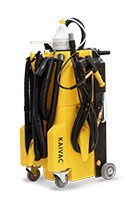KaiVac® 1250
No Touch
The KaiVac® 1250 is the most compact No-Touch Cleaning® system and is designed for smaller facilities.

Quick Start
Kaivac 1250 - Quickstart
Machine Prep
This video walks you through setting up and preparing the machine for basic operation.
Training
S-Setup the Restroom
How to properly prepare the restroom for cleaning. Steps included are picking up trash and litter, remove trash cans, flush toilets, place toilet seats down, and optional high dusting.
I-Inject Chemical
How to properly apply chemistry to restrrom fixtures and floors. Covered topics include selecting chemicals, turning chemicals on, placing spray gun in low pressure, creeating a fan spray pattern, proper application method, and estimated time to apply to differnet fixtures.
M-Manual Brush
How to properly scrub soiled grout lines and trouble areas around toilets, urinals, and sinks. This step is optional depending on soil levels.
P-Pressure Rinse
How to properly rinse fixtures using top down method. Covered techinques are the rim shot, slam dunk hinge cleaning, and getting to the hard to reach places.
L-Loop the Spray Line
How to properly wrap the spray line after use.
E-Extract and Dry
How to properly remove soiled liquid from the floor with the powerfull vacuum system. Also covered is methods for drying touchpoints after cleaning if needed.
Empty and Rinse the System
How to empty the machine after use and prepare it for the next restroom cleaning.
Charging the Battery
How to properly charge your power pack, either on the wall or on the machine.
First 21 Days
Welcome to No-Touch Cleaning
Getting Started: Chemical Setup
Getting Started: Chemical Setup
Getting Started: Apply Chemical and Rinse
Getting Started: Apply Chemical and Rinse
Getting Started: This Vacuum Sucks
Getting Started: This Vacuum Sucks
Getting Started: Cleaning out the Machine Daily
Getting Started: Cleaning out the Machine Daily
Getting Started: Take it Slow
Don't Make This Mistake
Don't Make This Mistake
Review of Week One Fundamentals
Rinsing Techniques
Rinsing Techniques
Bleed the Line
Reduce Brushing
Reduce Brushing
Blow Dry Surfaces
Blow Dry Surfaces
High Dusting
High Dusting
Partitions, Mirrors, Countertops
Partitions, Mirrors, Countertops
Hose Management
Hose Management
Power Cord Management
Power Cord Management
Daily vs. Deep Cleaning
Daily vs. Deep Cleaning
Five O'clock Shadow
Five O'clock Shadow
You're Making a Difference
You're Making a Difference
Congrats!
Congrats!
Maintenance
Inspect Squeegee Blades - Daily
Inspect the Aluminum Wand Fittings - Weekly
Release Spray Line Pressure - Daily
Lubricating the Pressure Gun - Monthly
Inspect HEPA Filter - Monthly
A clean dry HEPA filter ensures a machine’s vacuum motor runs efficiently. This video shows how to check the filter for build up of dust, soot, soils and water and replace if necessary. This inspection should be performed monthly or when troubleshooting poor vacuum suction or when water or suds are visible in the exhaust port.
Squeegee Head Replacement - Monthly
Troubleshooting
Priming the Pump - 1250
Gun Maintenance
Greg from Kaivac Technical Support walks you through the process of troubleshooting your spray gun. If you're having issues with the spray pattern, gun sticking, or mineral deposits inside the spray gun, this video provides simple tips and fixes.
Low Pressure
Greg from Kaivac Technical Support explains how to troubleshoot low spray pressure. Topics covered include; priming the spray line, blockage, gun issues, valve not open, clean water filter, chemical injector and more.
Priming the Pump
Greg from Kaivac Technical Support covers the three ways to prime your pump if it is not spraying water. Power priming uses the vacuum hose to pull water, forced priming uses water to push the system, and gravity priming is the last option.
Unsticking the Chemical Injector Check Valve
Austin from Kaivac walks through the process of freeing a stuck check valve in a No-Touch Cleaning chemical injection system
Vacuum Troubleshooting
Greg from Kaivac Technical Support covers the most common issues causing poor suction and no suction from your vacuum system. These include; clogs in the wand or hose, poor seal, float shut off, foam, HEPA filter, air leaks, loud vacuum motor, and more.